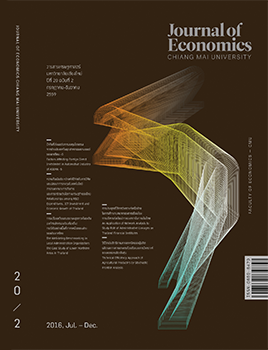การประยุกต์ใช้การวิเคราะห์เครือข่ายในการศึกษาบทบาทของการเชื่อมโยงการบริหารต่อเงินฝากของสถาบันการเงินไทย An Application of Network Analysis to Study Role of Administrative Linkages on Thailand Financial Institutes’ Deposit
Keywords:
การเชื่อมโยงของผู้บริหาร การวิเคราะห์เครือข่าย สถาบันการเงิน Executive linkages, financial institutes, Network AnalysisAbstract
บทคัดย่อ
การสร้างเครือข่ายระหว่างผู้บริหารของสถาบันการเงินเป็นการสร้างโอกาสในการเข้าถึงแหล่งข้อมูลข่าวสารนำมาซึ่งความได้เปรียบของสถาบันการเงิน การศึกษานี้มีวัตถุประสงค์หลักสองประการคือ การวัดดัชนีการมีเครือข่ายและศึกษาบทบาทของดัชนีดังกล่าวต่อปริมาณเงินฝากของสถาบันการเงิน โดยใช้ข้อมูลการดำรงตำแหน่งของผู้บริหารและข้อมูลเงินฝากของสถาบันการเงินไทยจำนวน 16 แห่งตั้งแต่ปี 2548 ถึงปี 2557 รวม 124 ตัวอย่าง การวัดดัชนีเครือข่ายใช้การวิเคราะห์เครือข่าย (Network Analysis) ด้วยโปรแกรม Ucinet6.0 พบว่าตลอดช่วงเวลาที่ศึกษาธนาคารแลนด์แอนด์เฮาส์มีค่าความเป็นศูนย์กลาง (Degree Centrality) สูงสุด ธนาคารอาคารสงเคราะห์มีค่าความเป็นศูนย์กลางประเภทความใกล้ชิด (Closeness centrality) และธนาคารไทยพาณิชย์มีความเป็นค่าคั่นกลาง (Betweenness centrality) มากที่สุด ส่วนแบบจำลองเงินฝากของสถาบันการเงินแบ่งเป็นด้านอุปสงค์และอุปทาน ด้านอุปสงค์ตัวแปรตามได้แก่ปริมาณเงินฝาก ส่วนด้านอุปทานตัวแปรตาม ได้แก่ ดอกเบี้ยจ่าย โดยปัจจัยที่ส่งผลต่อปริมาณเงินฝากในทิศทางเดียวกันอย่างมีนัยสำคัญทางสถิติได้แก่ เงินปันผลจ่าย หนี้สินของสถาบันการเงิน และประเภทของธนาคารขนาดใหญ่ของประเทศ 4 แห่งเช่นเดียวกับค่าความเป็นศูนย์กลางประเภทความใกล้ชิด และมีขนาดสูงกว่าค่าความเป็นศูนย์กลาง ส่วนการเกิดวิกฤติสินเชื่อซับไพร์มส่งผลต่อปริมาณเงินฝากในทิศทางตรงข้าม ในส่วนของแบบจำลองทางด้านอุปทานผลการศึกษาพบว่า ปัจจัยที่ส่งผลต่อดอกเบี้ยจ่ายในทิศทางเดียวกันได้แก่ ประเภทของธนาคารขาดใหญ่ของประเทศ 4 แห่ง เงินปันผลจ่าย หนี้สินของสถาบันการเงิน และเช่นเดียวกับค่าความเป็นศูนย์กลาง ส่วนการเกิดวิกฤติสินเชื่อซับไพร์มและยอดการให้สินเชื่อ ส่งผลต่อดอกเบี้ยจ่ายในทิศทางตรงข้าม เช่นเดียวกับด้านอุปสงค์ ผลการศึกษาชี้ให้เห็นว่า การมีเครือข่ายของผู้บริหารส่งผลต่อผลการดำเนินงานของสถาบันการเงินไทย ซึ่งสามารถสะท้อนถึงความไม่โปร่งใสและผู้ที่มีส่วนเกี่ยวข้องเช่น ธนาคารแห่งประเทศไทยจำเป็นต้องมีมาตรการในการดูแล
คำสำคัญ:การเชื่อมโยงของผู้บริหาร การวิเคราะห์เครือข่าย สถาบันการเงิน
ABSTRACT
The existing of network relationship between executives of financial institutes led to opportunity of information access and advantageous, the objectives of this study has two folds, measurement of networking indices and verification of its effect on deposit of financial institutes by employing data of executive on duty and deposit of 16 financial institutes during 2004 – 2014 or 124 examples in total. The application of network analysis for Ucinet 6.0 was used and found that Land and House Bank was the maximum degree centrality while Housing Bank possess the maximum level of Closeness and Siam Commercial Bank had the highest betweenness centrality. Model of deposit was divided to two models demand and supply models with dependent variable for the latter model was deposit amount and for the latter was interest expense. The significant variables for demand side were dividend bank liability and bank in the first four big banks with positive direction including all networking indices with the highest magnitude was degree, closeness and betweenness centrality respectively and sub-prime did negative affect on deposit amount. On the other hands, for supply side model all centrality indices showed the negative effect on interest expense. The results of this study implied that the linkages of executive networking brought about the better outcome of financial institutes and be able to reflex the intransparency and related authorities for example Bank of Thailand should be in action.
Key Words: Executive linkages, financial institutes, Network Analysis
Downloads
Additional Files
Published
Issue
Section
License
All opinions and contents in the CMJE are the responsibility of the author(s). Chiang Mai University Journal of Economics reserves the copyright for all published materials. Papers may not be reproduced in any form without the written permission from Chiang Mai University Journal of Economics.
ข้อคิดเห็นที่ปรากฏและแสดงในเนื้อหาบทความต่างๆในวารสารเศรษฐศาสตร์มหาวิทยาลัยเชียงใหม่ ถือเป็นความเห็นและความรับผิดชอบโดยตรงของผู้เขียนบทความนั้นๆ มิใช่เป็นความเห็นและความรับผิดชอบใดๆของวารสารเศรษฐศาสตร์ มหาวิทยาลัยเชียงใหม่
บทความ เนื้อหา และข้อมูล ฯลฯ ในวารสารเศรษฐศาสตร์มหาวิทยาลัยเชียงใหม่ ถือเป็นลิขสิทธิ์เฉพาะของคณะเศรษฐศาสตร์มหาวิทยาลัยเชียงใหม่ หากบุคคลหรือหน่วยงานใดต้องการนำทั้งหมดหรือส่วนหนึ่งส่วนใดไปเผยแพร่ต่อหรือเพื่อกระทำการใดๆ จะต้องได้รับอนุญาตเป็นลายลักษณ์อักษร จากวารสารเศรษฐศาสตร์ มหาวิทยาลัยเชียงใหม่





